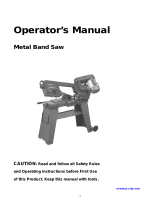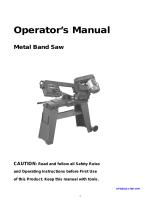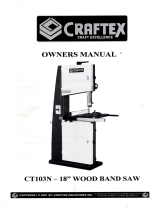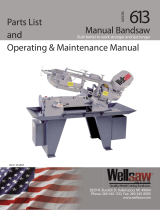
4
19. All visitors should be kept at a safe distance from
the work area. Make your workshop completely
safe by using padlocks, master switches, or by
removing starter keys.
20. Know the tool you are using; its application,
limitations, and potential hazards.
General Electrical Cautions
This machine should be grounded in accordance with
the National Electrical Code and local codes and
ordinances. The work should be done by a qualified
electrician. The machine should be grounded to
protect the user from electrical shock.
Wire Sizes
CAUTION: For circuits that are a great distance from
the electrical service box, the wire size must be
increased in order to deliver ample voltage to the
motor. To minimize power losses and to prevent
motor overheating and burnout, the use of wire sizes
for branch circuits or electrical extension cords
according to the following table is recommended:
Conductor
length
AWG (American Wire Gauge) number
240 volt lines 120 volt lines
0-50 feet No. 14 No. 14
50-100 feet No. 14 No. 12
Over 100 feet No. 12 No. 8
Table 1
Safety Instructions on Sawing Systems
1. Always wear leather gloves when handling
saw blade. The operator shall not wear gloves
when operating the machine.
2. All doors shall be closed, all panels replaced,
and other safety guards in place prior to the
machine being started or operated.
3. Be sure that the blade is not in contact with the
workpiece when the motor is started. The
motor shall be started and you should allow
the saw to achieve full speed before bringing
the saw blade into contact with the workpiece.
4. Keep hands away from the blade area.
5. Remove any cut off piece carefully while
keeping your hands free of the blade area.
6. Saw must be stopped and electrical supply
must be cut off before any blade replacement
or adjustment of blade support mechanism is
done, or before any attempt is made to change
the drive belts or before any periodic service or
maintenance is performed on the saw.
7. Remove all loose items and unnecessary
workpieces from the area before starting
machine.
8. Bring adjustable saw guides and guards as
close as possible to the workpiece.
9. Always wear protective eye wear when
operating, servicing, or adjusting machinery.
Eyewear shall be impact resistant, protective
safety glasses with side shields complying with
ANSI Z87.1 specifications. Use of eye wear
which does not comply with ANSI Z87.1
specifications could result in severe injury
from breakage of eye protection.
10. Nonslip footwear and safety shoes are
recommended.
11. Wear ear protectors (plugs or muffs) during
extended periods of operation.
12. The workpiece, or part being sawed, must be
securely clamped before the saw blade enters
the workpiece.
13. Remove cut off pieces carefully, keeping
hands away from saw blade.
14. Saw must be stopped and electrical supply
disconnected before reaching into cutting area.
15. Avoid contact with coolant, especially guarding
your eyes.
WARNING: Some dust, fumes and gases
created by power sanding, sawing, grinding,
drilling, welding and other construction activities
contain chemicals known to the State of
California to cause cancer and birth defects or
other reproductive harm. Some examples of
these chemicals are:
lead from lead based paint
crystalline silica from bricks, cement and
other masonry products
arsenic and chromium from chemically
treated lumber
Your risk of exposure varies, depending on how
often you do this type of work. To reduce your
exposure to these chemicals, work in a well-
ventilated area and work with approved safety
equipment, such as dust masks that are
specifically designed to filter out microscopic
particles. For more information go to
http://www.p65warnings.ca.gov/ and http://
www.p65warnings.ca.gov/wood.
WARNING: This product can expose you to
chemicals including lead which is known to the
State of California to cause cancer and birth
defects or other reproductive harm, and
ethylbenzene which is known to the State of
California to cause cancer. For more
information go to http://www.p65warnings.ca.
gov.























